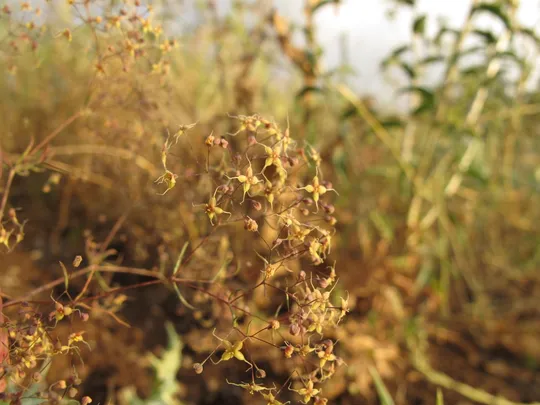Bristled-pedicelled Bedstraw
Galium chaetopodum





Galium chaetopodum was a plant that once grew, rarely, in many regions:
the Samaria Desert, Carmel Coast, Kinarot Valley, Hula Valley, Jezreel Valley and Upper
Galilee. The species was previously collected only at a few sites (1 or 2) in
each of the regions
and since the 1960s, it
has not been found again. Currently G. chaetopodum is
known only from the Golan (7 sites), Lower Galilee (16 sites) and from one site on the Gilboa. The 1991 survey found several sites in the Lower Galilee, in the area of Mimlah
Ridge and the southern Tsalmon Junction, mostly in traditional olive groves, where thousands of plants were
counted. This
area, in addition to the Bet Netofa Valley and the
Tur’an Valley, is the richest in
populations and the number of individuals. In 2005, Yoav Gertman found G.
chaetopodum at an unusual site near Yagur.
Fields, herbaceous
abandoned fields and traditional olive groves,
mostly on heavy soils that are flooded in winter and dry in summer. In Horan,
it grows in herbaceous fields on basaltic soil.
The genus Galium has 300 species of herbaceous plants with a square
stem, found in all the continents of the world, concentrated mainly in
temperate areas: in Europe (141 species) and in the Mediterranean Basin. Turkey has the greatest number of Galium
species – 101 species.
Galium chaetopodum was first collected in 1922 in the Jezreel Valley, by
Eig (1926), but was mistakenly identified as G. nigricans. In 1932, the researcher G. Samuelson
visited the Levant and after checking the Hebrew University, herbarium sheets
identified the species as new to science and named it G. uropetalum. However,
he did not describe the species according to accepted standards and only
proposed a new name, which he noted on the herbarium sheets. Following Samuelson's identification the
species appeared by that name in the old guide (1948). In 1949, Rechinger (Rechinger fil,
1949) edited the first part of the "Samuelson Herb Collection" the
herb collection that Samuelson left after his death. Rechinger determined the species was
new to science based on the plants collected by Samuelson in 1932 in abandoned
fields near the Tabha Valley (En Sheva) in the Kinarot Valley. He described the species and gave it a new name.
Unique features of G. chaetopodum include the long-filiform scattered
pedicels, and the long petal bristle. The leaf shape, flowers and fruit are
very similar to G. hierosolymitanum, G. setaceum and G. philistaeum. It differs from them in its greater
height, up to 50 cm, and relatively wider leaves, compared to the narrow leaves
of the other species. G. chaetopodum is similar in giant G. setaceum
plants, which has short pedicels and hairy fruit.
·
The main factors contributing to the range
reduction and extinction of Galium
chaetopodum on many of its sites are intensive
cultivation and herbicide spraying. This is true for most of the
sites in which it once grew and in most potential habitats, e.g.
fields and heavy soils. The same is true for other species whose
habitat is deep soil fields. In all the regions, except for the
Golan, the species was collected from sites of cultivated
fields whose vegetation is not natural.
·
Most
sites are not in nature reserves.
Two
sites where Galium chaetopodum grows should be monitored – the Mimlah Ridge
and the Tsalmon Junction.
A survey to
map the distribution of the plant in the Golan should be conducted,
since no rare
species survey has been conducted in this region. Data from the Golan Heights is from random collecting.
East Mediterranean. Galium chaetopodum is an endemic subspecies, whose distribution extends from northern Israel to
Horan (Ǧebel Druz) and the Damascus Basin in southern Syria.
Galium chaetopodum is an annual plant sub-endemic to Israel and southern
Syria, characteristic of mountainous valley soil in the Mediterranean transition
area, a habitat that has undergone drastic changes in agricultural management
over the past sixty years, and whose populations has been subsequently greatly
reduced.
Rechinger, K.H. 1949. Reliquiae Samuelssonianae 1. Arkiv for Botanik. Ser 2,1:323-324
Rechinger, K.H. 1959. Reliquiae Samuelssonianae 6. Arkiv for Botanik. Ser 2,6:419
Current Occupancy Map
| 1000 squre meter pixel | 5000 squre meter pixel | 10000 squre meter pixel | |
|---|---|---|---|
| number of observations | 0 | 0 | 0 |
| in total pixels | 0 | 0 | 0 |
| Family | Rubiaceae |
| Classification | On the endangered species list |
| Ecosystem | Mediterranean |
| Chorotype | Eastern Mediterranean |
| Conservation Site | Tsalmon Interchange in the Lower Galilee and Mimlah Ridge |
| Rarity |
1
2
6
|
|---|---|
| Vulnerability |
0
3
4
|
| Attractiveness |
0
0
4
|
| Endemism |
0
3
4
|
| Red number |
1
4.7
10
|
| Peripherality | N |
| IUCN category | DD EW EX LC CR EN VU NT |
| Threat Definition according to the red book | Endangered |
 Based on:
Based on:






